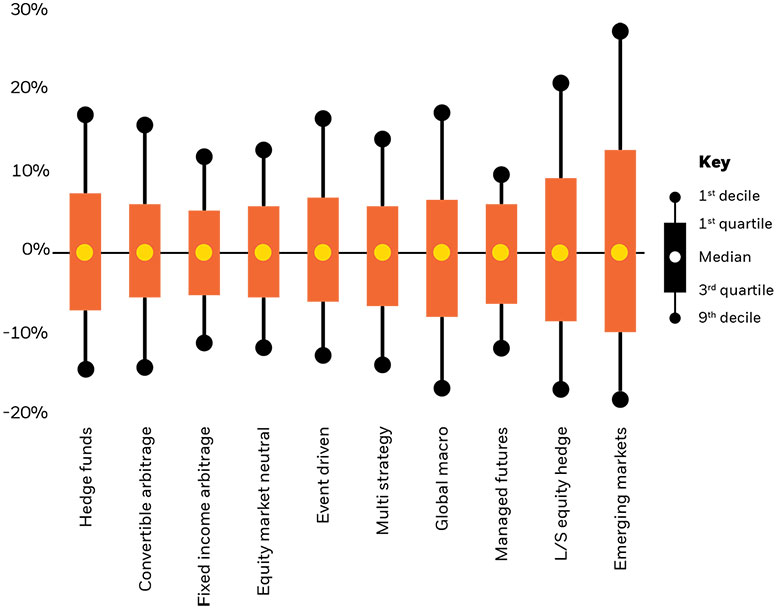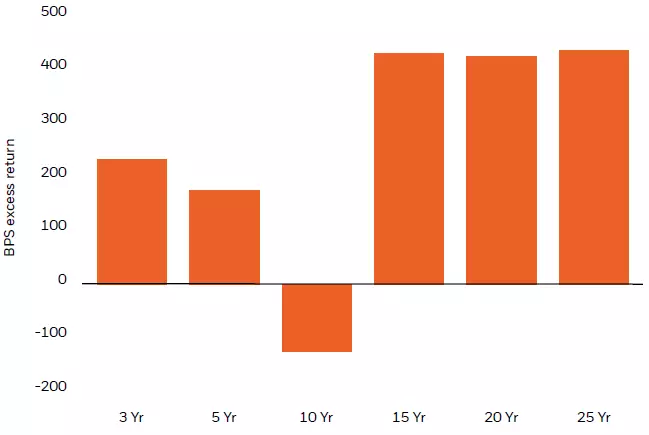
A new era of portfolio construction for endowments
Overview
Endowments face a unique set of challenges; their high return goals reflect a need to grow intergenerational equity while meeting ambitious spending requirements. At the same time, they have limited resources and face a broad opportunity set. Endowments have long been investment innovators, beginning with the formulation of the original endowment model 25 years ago. While many endowments, particularly those with more resources and access, have outperformed, the median has recently struggled to deliver returns above a 70/30 market benchmark according to the 2020 NACUBO-TIAA Study of Endowments. See chart below.
Performance varies by size
Annualized performance of a 70/30 benchmark, median endowment, and average large ($1bn+) endowment

Source: Data reflects MSCI ACWI, S&P 500, BBG Aggregate, and NACUBO-TIAA Study of Endowments as of Fiscal Year End, June 30, 2020.
In the forward-looking market environment, we consider four principles for endowment investing:
Focus on factor—not manager—diversification
Endowments have diversified across asset classes, particularly into alternatives, which now make up as much as 40-50% of a portfolio. With so much capital tied up in multiple, illiquid managers, it’s hard to know how the overall endowment is positioned. What may seem like appropriate diversification often results in unintended concentration risk. One of the benefits of a factor framework is the understanding of common drivers of return across allocations, regardless of asset class or public/private status.
To illustrate this point, the exhibit below shows the capital allocation of NACUBO’s US Endowment peer average portfolio. It encompasses a wide array of asset classes, including hedge funds (23%), private equity (22%), and real assets (11%) like infrastructure, timberland, and real estate. We use Aladdin, BlackRock’s proprietary risk technology, to measure the underlying risk factor exposure of each asset in the portfolio. As the second graph on the bottom demonstrates, the portfolio is far less diversified than it seemed, with nearly 90% of the risk coming from economic growth/equity risk factor.
There is a second important conclusion from this analysis: despite holding very different asset composition from the benchmark (in this case a mix of 70/30), the factor composition is very similar. It’s challenging to beat the market if your portfolio has the same exposure.
The whole portfolio view through a factor lens

Source: Aladdin, 184 months of equally weighted observations as of September 30th, 2020.
Control costs
Factors are not only a helpful way to rethink asset allocation choices; they help inform manager selection and portfolio construction. Most active managers have consistently underperformed their benchmarks net-of-fees. They also frequently carry systematic biases that are largely responsible for their performance. Aladdin helps us understand sources of a manager’s return, ultimately pointing to cheaper, more reliable factor-based alternatives. In many cases, what may appear to be excess return is merely reliance on commonly rewarded factors, such as excess market exposure, momentum, value, and quality. In the charts below, we show a sample portfolio using a manager-by-manager analysis. It reveals that two-thirds of the active risk can be largely explained by style-factor-level decisions (in yellow). The chart on the bottom right shows the components of that style bias, including a smaller size bias and an emerging market bias, among others.
Hidden biases

Source: BlackRock, August 2020. The numbers in the chart above are Z-Scores which are statistical measurements of the number of standard deviations the portfolio's style exposure is away from the estimated total equity universe. The stated scores are in excess of the benchmark.
Style bias can be pernicious. By employing an approach that relies too heavily on active manager selection and not enough on portfolio construction, many endowments end up with substantial value bias. This hurt performance significantly as growth powered most major equity market indices. We advocate an approach that uses the full toolkit of index, factors, and alpha-seeking sources of return. Index and factor-based investing provide better cost, liquidity, and transparency. For an endowment seeking 7.25% (inflation +5%), however, index investing alone will likely fall short of the target outcome. According to BlackRock’s long-term capital markets expectations, a global 70/30 index portfolio is now expected to return only 5.8%.1
Apply well-resourced convictions
Endowments have historically maintained sizeable hedge fund allocations as portfolio diversifiers and sources of idiosyncratic return. Until COVID, we experienced more than 10 years of sustained low market volatility, which challenged many managers and strategies. Today, many endowments are re-evaluating their hedge fund allocations to improve portfolio outcomes. Hedge funds can play a vital role in portfolio performance, but there are several key tenets to success.
- Manager research is increasingly critical. The difference between a top quartile manager and a median manager in the hedge fund universe is 10-20%. Selecting the right managers within each strategy is essential. See the exhibit below.
- Manage risk concentration. Accessing managers that consistently produce returns driven by idiosyncratic and secondary risk factors (as compared to primary market risk, or beta) can be challenging. We often help clients re-evaluate portfolio construction with adjustments to manager allocations, strategy weights, and position sizing.
- Understand negative selection biases resulting from screening criteria. Investors often rely on baseline screens such as minimum AUM or track record rather than more fundamental return drivers. Size, for example, can be an advantage and a disadvantage. It may foster benefits, such as an increased ability to take control positions and drive investment outcomes, but it may also hinder the ability to effectively implement investment theses.
- Consider different structures to isolate alpha opportunities, such as carve-out portfolios and co-investments. A significant amount of hedge fund excess return is driven by the ability to design unique exposures in partnership with managers that reflect a particular opportunity. Identifying and overweighting these superior opportunities can be the difference between meaningful alpha and disappointing beta.
- Improve terms: Always focus on fees, capacity, and transparency. Well-resourced teams identify attractive, idiosyncratic risk taking – but pay only for the true value added. Extensive due diligence is needed to identify the real origins of risk and returns.
Pick a winner
Dispersion of manager performance, annual returns, 2006 - 2019

Source: BlackRock Alternative Advisors (2020)
More innovative private market portfolios
The rules of the private equity game are changing. As McKinsey recently reported in their study, the NAV of the industry has grown sevenfold since 2002. Amid this rising competition, how can endowments reformulate private market allocations to achieve better outcomes?
Many endowment private equity portfolios are very expensive, heavily weighted to larger buyout funds and insufficiently diversified. Endowments and foundations often hold a portfolio of at least 10-20 managers across buyout, growth and venture. This equates to exposure to 150-200 deals. Overdiversification is an expensive way to access what ultimately becomes a portfolio of “private market beta.” Alpha potential has been diversified away. when we look at endowment private markets portfolios, we too often find a combination of over-diversification, high cost and insufficient differentiation in manager and strategy types. The result has been a disappointing decline in returns, as seen in the chart below.
Declining outperformance from traditional private equity approaches
Cambridge U.S. PE Index: PME Excess Return vs. Russell 3000

Source: Cambridge Associates (2020).
Our approach focuses on opportunistic, direct co-investments for 50-75% of the allocation, largely in the buyout and growth equity sectors, plus secondaries, particularly in the post-COVID-19 environment. At first glance, this seems like a large allocation — but as the portfolio reaches scale (i.e., 60–75 deals), overdiversification is less likely. Endowments have exposure to other sources of systematic risk in other areas of their portfolio; they can and should take advantage of private market inefficiencies by increasing their highest-confidence bets. Secondaries have also persistently outperformed primary funds over time and present unique value following a crisis period such as COVID-19.
The next chart shows fee savings on a $100mm portfolio by gradually replacing traditional private equity funds with co-investment funds. For a moderate co-investment allocation of 20%, savings of $3.6m in management fees and carried interest over the life of a diversified private equity program are possible. For a program with 50% co-investments, potential savings can be $9.1mm — or more than 900 basis points on a $100mm commitment over the entire lifetime of the fund. Fee savings should never be one’s sole motivation.
The power of better execution in private equity

Source: BlackRock Private Equity Partners. Gross deal level returns = 2.0x. Fund terms: 2% fee, 20% carry deal-by-deal, 8% hurdle. Co-investments terms: 0.75% fee, 10% carry European, 8% hurdle. Calculations based on $100m program and represent life-time estimates. Does not represent an actual product. It cannot be guaranteed that similar savings will be achieved in the future.
Conclusion
The endowment model boasts several historic insights that still hold true.
As long-term investors, endowments and foundations have exploited their unique ability to harvest illiquidity premiums. Endowments also tap into global investment opportunities and new asset classes through deep loyalty networks, tactically and strategically.
Endowments have also been known to pioneer new trading methods and opportunity sets, like co-investment rights. Since relative peer group performance serves as a primary benchmark, perpetual innovation has become a hallmark of endowment investing.
As some endowment portfolios have become more complex and diversified by manager, however, excess returns have been compressed to index-like results. These portfolios also bear great expense and lower liquidity. Meanwhile, the universe of liquid alternatives including index strategies has expanded substantially. Blending index and active strategies with true alpha opportunities will result in more optimal performance. ESG should be embraced as a source of resilience and alpha. Operating costs must be controlled much more diligently. And more concentrated investing is in order wherever deep expertise and valid research has led to high conviction.
Our approach combines factor-based technology with risk management tools and deep investment experience across the public and private markets. Our focus for the next era of endowment investing seeks to improve cost and capital efficiency, combined with truly unique alpha generation. Theory and practice both show such an approach can deliver consistently superior long-term outcomes.






